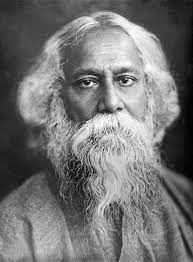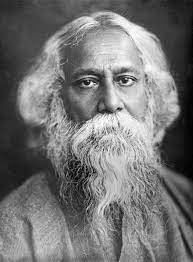Rabindranath Tagore's literary achievements are vast and influential, spanning various genres and earning him international recognition. As a poet, playwright, novelist, essayist, and short story writer, Tagore made significant contributions to Bengali literature and left a lasting impact on the literary world.
Poetry was Tagore's forte, and he is often regarded as one of the greatest poets in the Bengali language. His poetry reflects a deep connection with nature, love, spirituality, and the human experience. Tagore's poetic style is characterized by its lyrical beauty, philosophical depth, and profound insights into life's complexities. Some of his notable poetry collections include "Gitanjali" (Song Offerings), "Sonnets of Gitanjali," and "The Crescent Moon."
Tagore's works in fiction showcased his storytelling prowess. He penned numerous novels, short stories, and novellas, often exploring themes of love, relationships, social issues, and the human psyche. His novel "Gora" is considered a masterpiece, delving into issues of identity, religious tolerance, and nationalism. Other notable works of fiction include "The Home and the World," "Chokher Bali," and "Ghare-Baire" (The Wreck).
In addition to his poetic and fictional works, Tagore also contributed significantly to the realm of drama. He wrote numerous plays, both in verse and prose, that addressed social and moral issues while portraying complex characters and their conflicts. His play "The Post Office" gained international acclaim and has been performed worldwide. Tagore's theatrical works include "Chitra," "The King of the Dark Chamber," and "Red Oleanders."
Tagore's literary achievements extended beyond the written word. He was a multifaceted artist who composed over 2,000 songs, known as Rabindra Sangeet. These songs, combining poetic lyrics and melodic compositions, hold a special place in Bengali culture and have become an integral part of Indian and Bangladeshi music. Tagore's music was not only aesthetically pleasing but also carried profound spiritual and philosophical messages.
The impact of Tagore's literary achievements reached far beyond his homeland. His works were translated into numerous languages, exposing his poetic and philosophical vision to a global audience. In recognition of his exceptional literary contributions, Tagore became the first non-European to be awarded the Nobel Prize in Literature in 1913, primarily for his collection "Gitanjali." This accolade solidified his status as a literary giant and introduced Bengali literature to the world stage.
Tagore's literary achievements continue to resonate with readers and scholars worldwide. His writings embody universal themes of love, spirituality, human emotions, and social justice, making them relevant even in contemporary times. Tagore's ability to capture the essence of the human experience with profound simplicity and lyrical beauty remains an enduring legacy in the literary world.
Music and Songwriting of tagore
Rabindranath Tagore's contribution to music and songwriting is equally remarkable and forms an integral part of his artistic legacy. He composed a vast collection of songs known as Rabindra Sangeet, which blend poetry, melody, and emotion to create a unique musical form.
Tagore's musical journey began during his childhood, as he was exposed to various musical traditions and forms. Influenced by both Indian classical music and regional folk music, Tagore developed his distinct musical style that resonated with people from diverse backgrounds.
One of the key elements of Rabindra Sangeet is its lyrical depth and poetic beauty. Tagore's lyrics are infused with profound philosophical insights, exploring themes of love, nature, spirituality, and human emotions. His poetic verses are often introspective, evocative, and universal, capturing the essence of the human experience.
Tagore's compositions cover a wide range of musical genres and moods. His songs include devotional compositions, romantic melodies, patriotic anthems, and songs depicting the beauty of nature. Each composition carries its own unique flavor, reflecting the diverse range of emotions and experiences expressed through music.
The melodies of Tagore's songs are often characterized by their simplicity and elegance. He believed in the power of melody to convey emotions directly to the heart. His compositions make use of various musical scales and modes, blending Indian classical ragas with folk and regional musical elements. The melodic lines are often accompanied by delicate and intricate rhythms, enhancing the overall musical experience.
Rabindra Sangeet has had a profound impact on Bengali culture and has become an integral part of Indian and Bangladeshi music. The songs are deeply ingrained in the cultural fabric of the region, being performed and celebrated in various social and festive occasions, including weddings, festivals, and cultural events. The universality of Tagore's music has also transcended borders, with his compositions being appreciated and performed by artists across the globe.
Apart from their musical brilliance, Tagore's songs carry profound messages of love, unity, humanism, and social harmony. They often reflect his views on social issues, nationalism, and the pursuit of inner spiritual awakening. Tagore believed that music had the power to bring people together, bridge cultural gaps, and convey deep emotions that words alone could not express.
Tagore's musical achievements earned him great admiration and respect, both during his lifetime and posthumously. His compositions and melodies continue to inspire generations of musicians, singers, and listeners. Today, Rabindra Sangeet holds a significant place in the cultural landscape of Bengal and continues to be cherished as a testament to Tagore's artistic genius and his ability to touch the hearts of people through the power of music.
Tagore influenced sitar maestro Vilayat Khan and sarodiyas Buddhadev Dasgupta and Amjad Ali Khan. His songs are widely popular and undergird the Bengali ethos to an extent perhaps rivalling Shakespeare's impact on the English-speaking world. It is said that his songs are the outcome of five centuries of Bengali literary churning and communal yearning. Dhan Gopal Mukerji has said that these songs transcend the mundane to the aesthetic and express all ranges and categories of human emotion. The poet gave voice to all—big or small, rich or poor. The poor Ganges boatman and the rich landlord air their emotions in them. They birthed a distinctive school of music whose practitioners can be fiercely traditional: novel interpretations have drawn severe censure in both West Bengal and Bangladesh.
social and Political Activism of rabindranath tagore
Rabindranath Tagore was not only a prolific writer and composer but also a socially and politically engaged individual. Throughout his life, he actively participated in various social and political causes, advocating for social reform, cultural revival, and the freedom of India from colonial rule.
Tagore was critical of social issues prevalent in Indian society, such as the caste system and the oppression of women. He believed in the importance of equality, social justice, and the upliftment of marginalized communities. Tagore used his literary and artistic works as a platform to address these issues and promote social change.
As a social reformer, Tagore worked towards breaking down barriers and challenging orthodox traditions. He was a strong advocate for women's rights and empowerment, emphasizing the importance of education and equal opportunities for women. Tagore's progressive views on gender equality were reflected in his writings, where he portrayed strong and independent female characters who defied societal norms.
Tagore's activism also extended to political matters. He was a nationalist and a staunch supporter of the Indian independence movement. He believed in the need for India to regain its cultural and political autonomy from British colonial rule. Tagore used his influential position to raise awareness about the plight of the Indian people and to inspire a sense of national identity and pride.
One notable instance of Tagore's political activism was his protest against the Jallianwala Bagh Massacre in Amritsar in 1919. In response to the brutal massacre of peaceful protesters by British troops, Tagore renounced his knighthood, a symbolic act of defiance and protest against British oppression. This act highlighted his commitment to the cause of freedom and his solidarity with the Indian people.
Tagore's activism was not limited to India alone. He was a strong advocate for internationalism and believed in the unity of humankind. He emphasized the importance of cultural exchange and understanding between nations, and he used his influence to foster dialogue and collaboration among different cultures and civilizations.
Through his writings, speeches, and public engagements, Tagore played an active role in shaping public opinion and raising awareness about important social and political issues of his time. His influence extended beyond his literary and artistic achievements, making him a respected figure and a source of inspiration for many.
In summary, Rabindranath Tagore's social and political activism was characterized by his commitment to social reform, his advocacy for women's rights, his nationalist sentiments, and his belief in the power of culture and dialogue to bring about positive change. His contributions as an activist complemented his literary and artistic endeavors, making him a well-rounded figure who left a lasting impact on both Indian and global society.
Novals of rabindranath tagore
Rabindranath Tagore, the renowned Bengali polymath, made significant contributions to the world of literature through his novels. His novels reflect his keen observations of society, exploration of human emotions, and profound philosophical insights. Here are some notable novels by Tagore:
"Gora": Considered one of Tagore's masterpieces, "Gora" is a complex novel that delves into themes of identity, religious tolerance, and nationalism. The story revolves around Gora, the protagonist, who struggles with his mixed heritage and his search for his true identity in a society marked by religious and social divisions.
"The Home and the World" ("Ghare-Baire"): Set during the Swadeshi movement, which aimed for Indian economic and cultural independence from British rule, this novel explores the tensions between tradition and modernity, and the conflicts arising from personal relationships amidst political turmoil. The story follows Nikhilesh, Bimala, and Sandip, whose lives become intertwined in a love triangle.
"Chokher Bali": This novel depicts the story of Binodini, a young widow, and her relationships with the other characters in the book. The narrative explores themes of desire, betrayal, and societal expectations, shedding light on the struggles faced by women in a conservative society.
"Ghare-Baire" ("The Wreck"): This novel delves into the complexities of relationships and the clash between the personal and the political. It portrays the conflicts faced by the characters when they navigate love, loyalty, and their roles in the Indian independence movement.
"Char Adhyay" ("Four Chapters"): Set against the backdrop of political unrest and the Tebhaga movement in Bengal, this novel follows the life of Atul, a revolutionary. Through Atul's experiences, Tagore explores the disillusionment and dilemmas faced by those involved in political activism.
Tagore's novels are characterized by their introspective nature, rich character development, and exploration of social and political themes. His writing style combines lyrical prose with deep philosophical insights, reflecting his poetic sensibilities. Tagore's novels not only entertain but also provoke thought and inspire readers to reflect on the complexities of human existence and the world around them.
Overall, Tagore's novels offer a deep understanding of the human condition, societal dynamics, and the struggles faced by individuals in a rapidly changing world. His literary works continue to be celebrated for their timeless relevance, making Tagore one of the most revered and influential novelists in Bengali and world literature.
conclusion
Rabindranath Tagore was a polymath who reshaped Bengali literature and music, as well as Indian art with Contextual Modernism in the late 19th and early 20th centuries. Author of Gitanjali and its "profoundly sensitive, fresh and beautiful verse," he became the first non-European to win the Nobel Prize in Literature in 1913. Tagore's poetic songs were viewed as spiritual and mercurial; however, his "elegant prose and magical poetry" remain largely unknown outside Bengal. He is sometimes referred to as "the Bard of Bengal".
Tagore was born in Calcutta (now Kolkata) into a wealthy Bengali family. His father, Debendranath Tagore, was a prominent Brahmo Samaj leader, and his mother, Sarada Devi, was a devout Hindu. Tagore was educated at home by private tutors and at the Oriental Seminary in Calcutta. He began writing poetry at a young age, and his first collection of poems, Manasi, was published in 1890.
Tagore was a prolific writer, and he wrote in a variety of genres, including poetry, fiction, drama, and essays. He is best known for his poetry, which is characterized by its lyrical beauty and its philosophical depth. His most famous poems include "Where the Mind is Without Fear", "Gitanjali", and "The Crescent Moon".
Tagore was also a talented musician, and he composed over 2,000 songs, known as Rabindra Sangeet. These songs are still popular in India and Bangladesh, and they are often sung at weddings, festivals, and other celebrations.
Tagore was a social reformer, and he was critical of the caste system and the oppression of women. He was also a nationalist, and he supported the Indian independence movement. In 1919, he protested the Amritsar Massacre by returning his knighthood to the British government.
Tagore was a versatile and gifted artist who made significant contributions to Bengali literature, music, and art. He was a pioneer of Contextual Modernism in India, and his work helped to shape the course of Indian culture. He is considered one of the greatest Bengali writers of all time, and his work continues to be read and enjoyed by people all over the world.
In conclusion, Rabindranath Tagore was a towering figure in Indian culture and literature. His work has had a profound impact on generations of readers and artists, and his legacy continues to inspire people all over the world.





Comments
Post a Comment